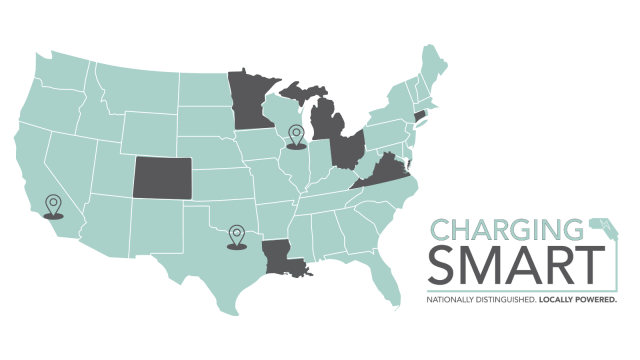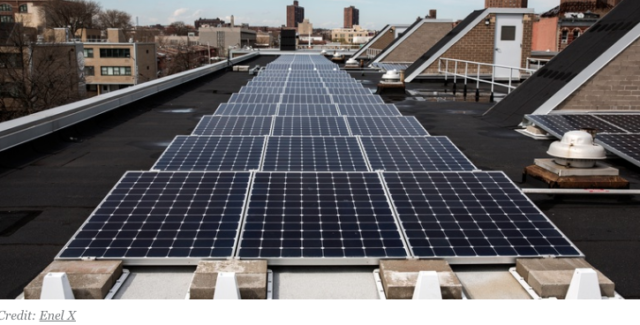Solar America City–New Orleans: Building a Green Workforce in the Crescent City
For me, New Orleans conjures up aromas of French Market coffee and Beignets, sounds of the Jazz Festival in May, and outrageous Mardi Gras extravaganzas. On the not-so jubilant side, I’m reminded of Hurricanes Camille (1969), Andrew (1992), Katrina and Rita (2005) and Gustav (2008), recalling images of devastated communities, burdened with prolonged power outages…
 For me, New Orleans conjures up aromas of French Market coffee and Beignets, sounds of the Jazz Festival in May, and outrageous Mardi Gras extravaganzas. On the not-so jubilant side, I’m reminded of Hurricanes Camille (1969), Andrew (1992), Katrina and Rita (2005) and Gustav (2008), recalling images of devastated communities, burdened with prolonged power outages for days, weeks, months even.
For me, New Orleans conjures up aromas of French Market coffee and Beignets, sounds of the Jazz Festival in May, and outrageous Mardi Gras extravaganzas. On the not-so jubilant side, I’m reminded of Hurricanes Camille (1969), Andrew (1992), Katrina and Rita (2005) and Gustav (2008), recalling images of devastated communities, burdened with prolonged power outages for days, weeks, months even.
Despite Louisiana’s long-standing reliance on oil and gas to fuel its economy, renewable energy has received an impassioned greeting as New Orleans rebuilds for the 21st Century. As a result, perhaps no other city in the U.S. has the unique opportunity to emerge as a solar city as does New Orleans.
New Orleans became a DOE Solar America City in 2007, and in just 18 months, the New Orleans Solar America Cities project has achieved remarkable progress toward its goals. “John McGowin, City of New Orleans Energy Manager, is now the lead for the partnership,” said Kevin Lynn, DOE’s Tiger Team lead for New Orleans, “and he’s doing a great job keeping the project on track.”
From a paucity of state incentives to an enviable record, since January 1, 2008, Louisiana offers a property tax exemption for solar energy systems (including water, space, and pool systems), and generous residential tax credit of 50% of the first $25,000 of the cost of each solar system installed. If your tax credit exceeds your tax liability, rather than carry the remainder over to subsequent years as done in the vast majority of states, the credit is refundable.
That 50% solar tax credit, along with energy efficient and green building businesses and products, was a big feature at the 53rd Annual New Orleans Home and Garden Show, held at the Superdome in early March 2008. DOE and New Orleans Solar America partners staffed a booth where a large PV panel was on display, along with information about solar energy. In fact, a large billboard outside the Superdome drew onlookers’ attention to the Louisiana solar tax credit and the new Solar Power New Orleans web site.
Keeping up the pace, in June, NOLA held a Solar Summit where all the major players including installers, the New Orleans permitting office, the utility (Entergy), the Historic District Landmark Commission, and the local technical colleges met to present perspectives and bring up obstacles to installing solar. “As a result,” said Lynn, “NOLA now has a solar expert in the permitting department and Entergy has reduced its solar interconnection policy to two pages. They’re moving along so quickly.”
Numerous meetings on installing PV in the network grid (Central Business District) are ongoing, and the National Renewable Energy Laboratory (NREL) is leading an effort as part of a cross-cutting activity to inform utilities how to install PV correctly on networks based on case studies from DC, San Francisco, New York, and Denver.
As if this isn’t enough to keep busy people even busier, training the potential workforce in Louisiana is one of the larger components in the partnership’s plan.
“Training is one of the partnership’s major tasks,” say Lynn. “We had FSEC come in and do code official and installer training. Stephen Shelton, Executive Director of Louisiana CleanTech Network (LCTN), has done a great job bringing in an expert from Austin to keep the training on a high level.”

Shelton partnered with the Louisiana Community and Technical College System (LCTCS) and Janet Hughes of Austin to develop a comprehensive NABCEP approved training program for Louisiana. DOE and Shelton looked to the LCTCS when searching for a place to conduct the training in the New Orleans area. As a result, the solar training program is now part of a statewide effort of the Louisiana Community and Technical College System to help make it easier for Louisiana to go green.
Janet Hughes, co-founder of ADVEN, LLC, a full service consulting firm specializing in solar energy system design and workforce training, has been involved in the solar industry for over 10 years in Texas. As lead trainer for Louisiana’s NABCEP Entry Level Certificate of Knowledge program, she’s currently training eight solar instructors to prepare them for lead instructor positions for the growing training effort in Louisiana.
“The training course teaches the NABCEP Photovoltaic (PV) Entry Level Certificate of Knowledge learning objectives, and has been approved by NABCEP,” said Hughes. “This course fulfills the educational requirements for Category ‘B’ of NABCEP’s Solar PV Installer Certification, and demonstrates that the student has passed an industry-designed exam based on learning objectives developed by subject matter experts. Though the Certificate by itself does not qualify an individual to install PV systems, students holding this industry-sponsored Entry Level Certificate may find that their employment opportunities are enhanced by starting the job with an understanding of the basic terms and operational aspects of a PV system. All graduates receive a certificate of completion,” said Hughes.
“Since June, we’ve trained a total of 93 students, and 15 have taken the Entry Level Certificate of Knowledge exam,” said Hughes.
There’s been an impressive turnout for these classes.
“Some students want to be installers and will be looking for jobs with existing companies while professionals and trades people like engineers, architects, builders, electricians, HVAC technicians, plumbers, roofers and carpenters will be adding this expertise to their existing practice for a competitive edge,” said Hughes. “Many are expanding there existing businesses and others are forming solar contracting companies. Whatever their previous experience, everyone is looking to branch out.”
The training course is a combination of lecture, hands on training, on-the-job training, real world solar applications, solar contractor training, National Electrical Code (NEC) information, explanations of The State of Louisiana and Federal tax credit incentives, and Louisiana solar installation contractor requirements.
“The classes are interactive and include a lot of class participation,” said Shelton. “The ‘on-the-job-training’ includes the complete installation of a fully functional solar electric system, from installing the solar panels on the roof to the balance of systems which are completely wired and functioning. The two days of hands-on installation training includes all materials and tools to do the job right.”
The courses follow the ISPQ standards and NABCEP PV task analysis including recommended safety procedures, system design, electrical code and industry standard practices.
“The 48-hours of instruction include classroom and hands-on instruction with real life solar site-specific knowledge,” said Hughes. “The hands-on training is thorough with in-the-field site analysis, mechanical and electrical design based on specific site conditions, site-specific safety issues and construction issues. The trainees use tools and test equipment, best practice construction skills and specific site code and inspection issues. It’s a very comprehensive and thorough training regimen.”
How is the hands-on segment taught?
“We build an entire 1 kW system at Louisiana Technical College Lafayette and New Orleans’ campuses,” said Hughes. “Just to give you an idea of how detailed the work is, the trainees install and attach racking brackets through shingles into roof framing every four feet to withstand 130 MPH wind speeds. They mount and wire the solar panels, run conduit and wire to the equipment wall, ground the solar panels frames and system, mount and wire the disconnect switches and the inverter, and then wire the solar system into a breaker in the service breaker panel. They do it all.”
For more than 16 years, Hughes has been an electrical contractor, and a Master Electrician for 11 years. She’s installed hundreds of PV systems. Safety and attention to detail are first, second and third nature to Janet.
“Lafayette’s campus has an outdoor built-up roof that folds up and can be moved with a forklift,” said Hughes. “At the New Orleans campus, their built-up roof is inside in the carpentry lab and is a full scale residential roof. Materials for the Lafayette campus came from a grant to develop solar installer training into their curriculum and is scheduled to be launched by June 2009.”
Hughes is in the process of helping both campuses develop curriculum and train their existing instructors. “Right now, we have LTC instructors-HVAC, Electrical, Electronics, eight in all-sitting in on every class,” said Hughes. “In fact, the HVAC and Electrical instructors sitting in at Lafayette classes took the Certificate of Knowledge (COK) test on December 15th. A female electrician who is an instructor at the New Orleans Technical College-Jefferson Campus has taught a couple of classes and is on her way to becoming a lead instructor; she’s a great instructor with astonishing hands-on skills.”
To make sure the trainees are getting the best training and to continually improve her training methods, Hughes distributes evaluations. “We want to know how we can improve the five-day training,” said Hughes, “and something that keeps coming up is the switch from the three-day classroom/two day hands on model to a combination of classroom lecture followed immediately by a hands-on to reinforce what they’ve just learned. So we’ll do a lecture on racking, then we’ll go and practice what we learned about racking on the roof, rather than wait till last couple of days to do that hands-on segment. I think it makes so much sense to combine the two on a daily basis.”
Janet has recently been invited by Sidney Bolfing with the Texas State Technical College/Waco to develop a NABCEP-approved solar electric installer training course in partnership with TSTC/Waco campus. The initial plan is to replicate the training program that has been so successful in Louisiana on the Waco campus, and then expand to other Texas cities.
Nationwide, renewable energy training is in high demand. Classes fill up quickly, and strong, talented and knowledgeable instructors are in short supply. There’s been talk among some of the Solar America City Tiger Team members of a national effort to train instructors in all of the 25 Solar America Cities. “With the eight-year extension of the Investment Tax Credit,” says Hughes, “everyone is moving as quickly as humanly possible to train installers to some recognized standard of competency. And currently, there simply aren’t enough instructors to train the installers.”
Contributing to this article: Janet Hughes, Stephen Shelton, Kevin Lynn
Photo: courtesy of the Times-Picayune


